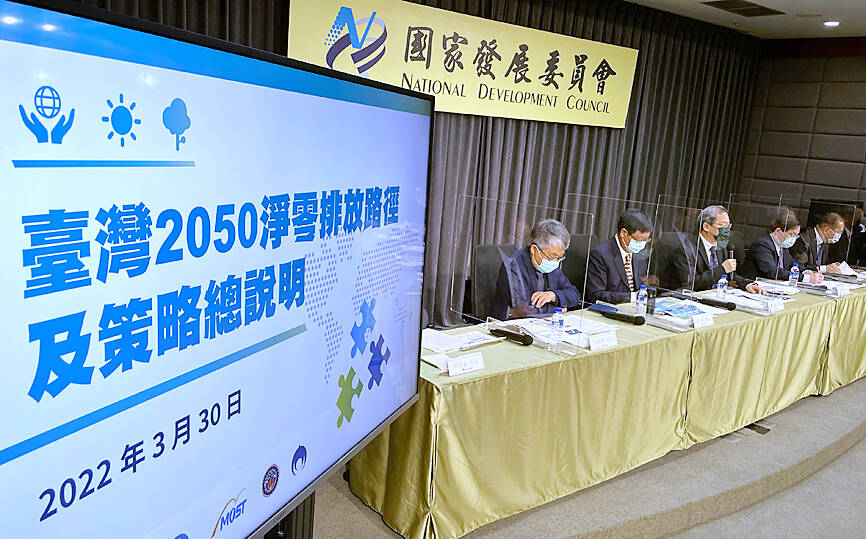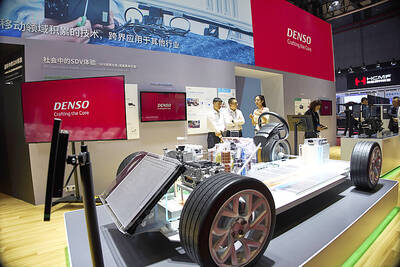A carbon exchange that is set to open in the middle of next year would help the government meet its net zero emissions goal by 2050, the National Development Council (NDC) said on Saturday.
In a statement released to mark Earth Day, the council said the exchange would help integrate resources and capital to push for emissions reduction through carbon credit trading.
The council said setting up the exchange is part of efforts to reach the 250 net zero emissions goal, which was enshrined into law by the Climate Change Response Act (氣候變遷因應法) in February.

Photo: Liu Hsin-de, Taipei Times
The act also stipulates a carbon border adjustment mechanism, which enables the government to levy fees on imports of carbon-intensive products.
As a result, Taiwan would from 2050 be bound to ensure that greenhouse gas emissions do not exceed the amount of greenhouse gases removed from the atmosphere, the NDC said.
The act also forms the legal basis for the government’s plan to collect carbon fees and introduce a carbon pricing scheme, and provides incentives to cut emissions, the council said.
Companies that are unable to reduce emissions due to high costs could purchase credits on the carbon exchange to offset their emissions, analysts said.
On Thursday, the Taiwan Stock Exchange (TWSE) announced that it is working with the National Development Fund to set up a carbon exchange.
Registration for the new platform would open in the middle of next year, it said.
The digital carbon exchange is expected to offer standardized contracts to buyers and sellers of emissions credits.
The TWSE said that it set up a task force to prepare the platform last year.
The task force has visited Japan, South Korea and Singapore to learn about carbon credit systems, it said.
After the Climate Change Response Act was passed in January, the TWSE started working with the Financial Supervisory Commission, the Environmental Protection Administration and the Ministry of Economic Affairs to expedite the establishment of the carbon exchange, it said.
The TWSE said it is planning to consult with business groups and environmental protection groups on the matter.
The carbon exchange would offer domestic and international carbon credit transactions and other services, including educational programs, the TWSE said.
The carbon exchange would help companies reach their individual carbon reduction targets and reduce their costs to reduce emissions, it said.
The platform is expected to entice Taiwanese and international companies to cooperate on emissions reduction, and help Taiwan boost its efforts to develop its economy while taking environmental protection and social sustainability into account, it said.
The NDC said that the local bourse and the National Development Fund would initially inject funds into the carbon exchange to ensure that the platform would serve as a comprehensive carbon credit exchange mechanism for Taiwan in accordance with the nation’s environmental protection rules.

GROWING OWINGS: While Luxembourg and China swapped the top three spots, the US continued to be the largest exposure for Taiwan for the 41st consecutive quarter The US remained the largest debtor nation to Taiwan’s banking sector for the 41st consecutive quarter at the end of September, after local banks’ exposure to the US market rose more than 2 percent from three months earlier, the central bank said. Exposure to the US increased to US$198.896 billion, up US$4.026 billion, or 2.07 percent, from US$194.87 billion in the previous quarter, data released by the central bank showed on Friday. Of the increase, about US$1.4 billion came from banks’ investments in securitized products and interbank loans in the US, while another US$2.6 billion stemmed from trust assets, including mutual funds,

Micron Memory Taiwan Co (台灣美光), a subsidiary of US memorychip maker Micron Technology Inc, has been granted a NT$4.7 billion (US$149.5 million) subsidy under the Ministry of Economic Affairs A+ Corporate Innovation and R&D Enhancement program, the ministry said yesterday. The US memorychip maker’s program aims to back the development of high-performance and high-bandwidth memory chips with a total budget of NT$11.75 billion, the ministry said. Aside from the government funding, Micron is to inject the remaining investment of NT$7.06 billion as the company applied to participate the government’s Global Innovation Partnership Program to deepen technology cooperation, a ministry official told the

Taiwan Semiconductor Manufacturing Co (TSMC, 台積電), the world’s leading advanced chipmaker, officially began volume production of its 2-nanometer chips in the fourth quarter of this year, according to a recent update on the company’s Web site. The low-key announcement confirms that TSMC, the go-to chipmaker for artificial intelligence (AI) hardware providers Nvidia Corp and iPhone maker Apple Inc, met its original roadmap for the next-generation technology. Production is currently centered at Fab 22 in Kaohsiung, utilizing the company’s first-generation nanosheet transistor technology. The new architecture achieves “full-node strides in performance and power consumption,” TSMC said. The company described the 2nm process as

JOINT EFFORTS: MediaTek would partner with Denso to develop custom chips to support the car-part specialist company’s driver-assist systems in an expanding market MediaTek Inc (聯發科), the world’s largest mobile phone chip designer, yesterday said it is working closely with Japan’s Denso Corp to build a custom automotive system-on-chip (SoC) solution tailored for advanced driver-assistance systems and cockpit systems, adding another customer to its new application-specific IC (ASIC) business. This effort merges Denso’s automotive-grade safety expertise and deep vehicle integration with MediaTek’s technologies cultivated through the development of Media- Tek’s Dimensity AX, leveraging efficient, high-performance SoCs and artificial intelligence (AI) capabilities to offer a scalable, production-ready platform for next-generation driver assistance, the company said in a statement yesterday. “Through this collaboration, we are bringing two